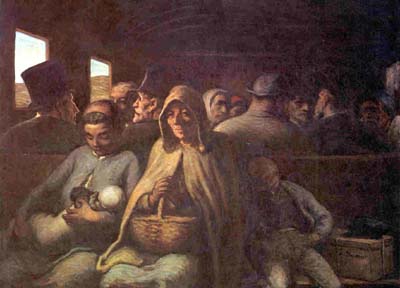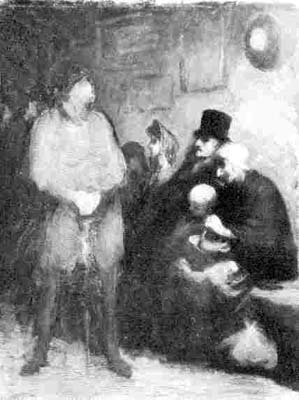
Bulletin 9-10 (V:1-2), 1967
Home
Français
Introduction
History
Annual Index
Author &
Subject
Credits
Contact


Daumier's
Travellers
by Willard E. Misfeldt, Instructor, School of Art
Bowling Green University, Bowling Green, Ohio
Pages 1 | 2
| 3
In these lithographs, Daumier's humour is never bitter. He sees
these situations as sometimes amusing, sometimes even a little disgusting, but, since these are cartoons, never as poignant or
dramatic. His concern is empathic: while he satirizes the
passengers he sympathizes with them. He is, after all, one of them.
It is important to realize this in order to understand how he
arrived at such a compassionate understanding of the
insignificant, anonymous travellers in his paintings after two
decades of gently ridiculing them in his cartoons.
Around 1860 Daumier seems to have renewed an acquaintance that had
apparently lapsed for a few years. This was his friendship with
the writer and caricaturist, Henri Monnier, whom Daumier had
caricatured in 1852 in the role of Joseph Prud'homme, one of
Monnier's own fictional creations. (7) In the French language the
name Prud'homme would in time come to denote someone who utters the
silliest banalities with the most smug solemnity. Daumier paid
Monnier- who himself had dealt with the theme of public conveyances in his caricatures of the late
1850's - the
backhanded compliment of portraying him in an 1884 lithograph as
Prud'homme in a third class carriage (plate 6). This
composition is useful in dating the carriage paintings. Just as
Monnier had come to resemble Prud'homme over the years, Daumier had
come to identify himself with the drab, lower-class people he had
been portraying in his cartoons for two decades.
In the early 1860's when Daumier was able, because of forced
unemployment, to turn at last to painting in oil, he used as one of
his major themes people travelling in carriages (plate 7) and
waiting in depots. It is interesting to note that this theme now
disappeared from his cartoons; whether this was because of public
satiety or because the theme had assumed a more personal
significance for Daumier himself, is not certain. Nevertheless his
paintings and drawings of travellers grew directly out of his work
as a caricaturist and were perhaps stimulated by his friendship with
Monnier. The paintings, unlike the cartoons, are without captions,
and as they do not deal with specific situations, they transcend
the limits of the particular and assume a generic or universal quality. They are generally interpreted as being incisive statements
about the modern predicament of the lonely crowd or as showing
Daumier's compassionate concern for the anonymous nobodies of
Paris,
these qualities making them just as relevant today. While accepting
these interpretations I should like to suggest that these paintings
have a far broader meaning which makes them significant not only for
the nineteenth and twentieth centuries, but for the whole range of
human history.
In these paintings Daumier reports no incidents; there is no
dramatic action. The people sit, dull and withdrawn, in the
constricted and characterless interior of a lowly railway carriage.
Daumier sees them as fellow passengers and paints them in a broad,
powerful and impulsive manner belying the detachment that might be
inferred from the quiet, stoic poses. The landscape in Daumier's
paintings, unlike that in the Travelling Companions (plate 8)
by his British contemporary, Augustus Egg, is of no significance;
there is neither point of origin nor of destination, neither
arrivals nor departures. People are being carried somewhere - it
does not matter where - by an engineering marvel, a product of the
new age of science and technology.
While one of the aspects of this new travel was the possibility of
freeing people from a fixed place where their families had lived for
generations, and allowing them to move some - where else, quite often
that "somewhere else" was the impersonal world of the big
city where they would find the same kind of isolation as they would
within the microcosm of the third-class carriage.
In Daumier's waiting-rooms (plate 9) as in the carriages, there is
in fact no setting, or the setting is generalized into something
not tied to a particular time or place. There is nothing of the
sense of an occasion, although at this time the great terminals
were sometimes used for such impressive ceremonies as a reception of
visiting royalty by Napoleon and the Empress Eugénie, or the
obsequies in 1864 of the composer Meyerbeer, held at the Gare du
Nord which was draped in elaborate mourning. Characteristically,
Daumier's focus within the terminals is not on arrivals or departures, or even on encounters between
individuals, but on an
unchanging state where neither beginning nor end has any meaning.
Can one justify an interpretation of these people as nomadic symbols? Daumier himself was no stranger to displacement: the Daumier
family moved at least twelve times within the city of Paris between
their arrival in 1816 and Honoré's incarceration at Sainte-Pélagie
in 1832. (8) And a number of his other works, many of them painted
during this decade, support this interpretation. In a general way,
we may observe that the artist does not paint Second Empire Paris
per se: he does not show any of the impressive features or
activities of the world's grandest capital. He avoids institutional
focal points. But more important than what he avoids is what he
paints. About 1848 he painted a series of fugitives and emigrants,
probably people displaced by the political upheavals of that year
and forced to flee to Algeria. Anonymous and oppressed, they
trudge forlornly through the bleak world, whipped on by an
uncompromising fate. In one sense, they are the real
ancestors of the people in the third-class carriage paintings.
But even more significant is the fact that at the same time he was
painting railroad travellers, Daumier was taking up another theme
involving people without a fixed place. These are the saltimbanques
or itinerant street entertainers in the drawing from the Wadsworth
Atheneum. They are not gay, laughing entertainers but forlorn
wanderers cast forever adrift in the impersonal world of the large
city. In the 1860's Daumier also turned to the Don Ouixote theme. (9)
Generally he set its narrative against bleak surroundings with no
other sign of human activity and very little action. It has been
suggested that Daumier felt that he was like Gervantes' hero - a
buffoon, a non-hero and a wanderer - whose journeys were usually in
futile efforts to right wrongs.
Daumier's travellers are non-heroes also, but unlike the clownish
knight, they have no mission. These uprooted people, dislodged from
a place of their own and going nowhere, exist simply and
undramatically; they are not players in a drama that has a
beginning, a climax and a resolution. Generalized and monumental,
these homely people transcend the specific situation of their
pointless journey and become universal symbols for the exile in the
world, for the nomad throughout history.
Next Page | Notes
1 | 2
| 3
Annual Index | Author & Subject | Credits | Contact
This digital collection
was produced under contract to Canada's Digital Collections program,
Industry Canada.
"Digital
Collections Program, Copyright
© National Gallery of
Canada 2001"